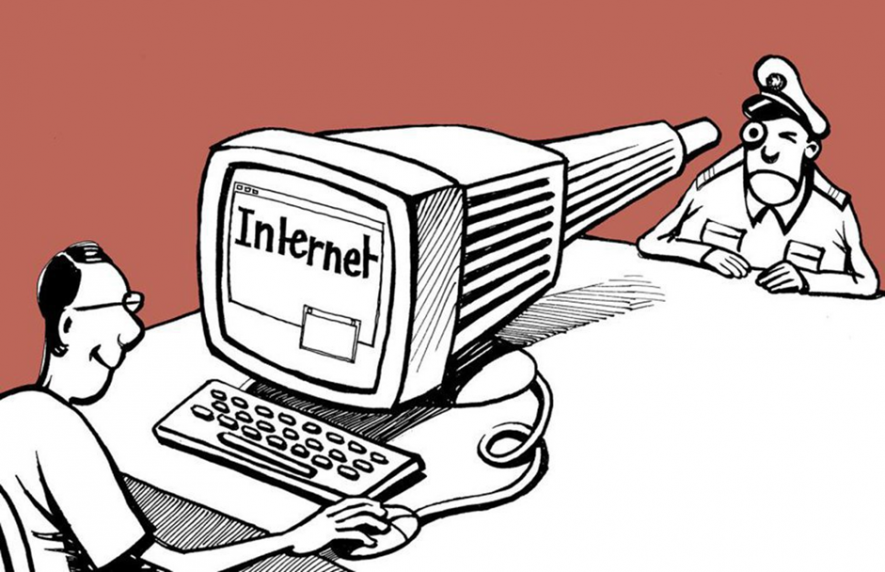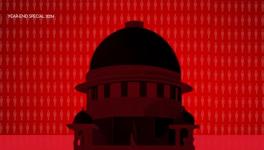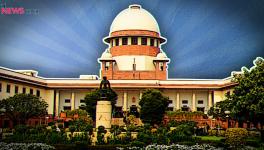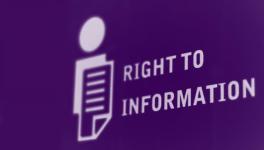Amid the recent lawsuit against the Union Government by Twitter, online censorship has come under intense scrutiny. While it is necessary to regulate the content posted on social media platforms, the same cannot be done to stifle dissent and criticism of the government.
As per the recent findings of Twitter’s global transparency reports, the legal demands by the Indian government and Indian courts to get content removed from the platform witnessed a 48,000 per cent increase between 2014 and 2020. Additionally, as per data shared in Parliament, the number of orders to block content on social media sites by the Indian government went up by almost 2,000 per cent during the same time period.
Where does the government derive its power to block content on social media?
The practice of removing content and blocking accounts on social media is nothing new. In the past few years, Twitter has often made headlines for removing content at the government’s request.
The government derives its extensive powers to curtail online content from Section 69A of the Information Technology Act, 2002 (‘IT Act’). This provision empowers the government to block public access to any information through any public resource. Behind the veil of this section, the government ordered social media platforms to take down 9,849 links from their platforms in 2020, compared to 471 in 2014, as per Twitter’s transparency report. It is imperative to note here that these content removal requests are in addition to the self-filtration policy adopted by social media platforms to remove hateful, discriminatory, and violence-enabling content.
Section 69A mentions a few grounds under which the blocking orders can be issued by the government. These grounds are “the interest of the sovereignty and integrity of India, defence of India, the security of the state, friendly relations with foreign states or public order or for preventing incitement to the commission of any cognizable offence relating to the above.”
Another provision that empowers the government to order the removal of content is Section 79 of the IT Act and its allied rules. However, according to the statement of an intermediary (that is, a social media platform or an internet service provider), the government prefers section 69A over this due to the opaque nature of the former.
Also read: Content takedown and users’ rights
The bigger issue here is not even the content takedowns ordered by the government, but the secrecy surrounding the whole process. As per the blocking rules, the entire blocking process is supposed to be executive-driven, which requires the maintenance of strict confidentiality concerning the blocking orders.
Transparency is the backbone of democracy. Unless there is transparency, the government cannot be held accountable.
In such a situation, ascertaining the validity and reasonableness of a blocking order becomes impossible, thereby paving the way for the issuance of arbitrary and illegitimate orders by the government.
Can the government order removal of content without providing the content creator a chance for a hearing?
It is often assumed that the government can arbitrarily order content removal without providing the creator a chance to contest such an order.
A person cannot contest the wrongful removal of content unless the government provides the content blocking order levied against their account or posts. However, there is considerable ambiguity surrounding content removal orders made under section 69A as it stands today.
Transparency is the backbone of democracy. Unless there is transparency, the government cannot be held accountable.
Rule 8 of the blocking rules requires the designated officer to make all reasonable efforts to identify the person or intermediary and computer resource hosting such information, and when the same has been identified, the officer is required to issue notice for submission of reply and clarifications.
However, it has been observed that the authorities, instead of intimating the content creator regarding the issuance of such an order, would give a hearing to Twitter. In such a situation, Twitter has no personal interest or incentive to challenge the order’s validity, especially when its non-compliance can attract fines or land it in jail.
Also read: Twitter versus government: The gravamen of restricted free speech
In its landmark judgment in Shreya Singhal versus Union of India (2015), the Supreme Court considered, among other things, the constitutional validity of section 69A and its allied rules. In this case, the contention of the petitioner was that according to the existing procedure in the blocking rules, the originator of the information was not guaranteed any pre-decisional hearing.
The Supreme Court, in its judgment, made it abundantly clear that in cases where the content creator has been identified, they must be provided written reasons and a hearing regarding such content removal order issued by the government. Therefore, any person whose content was censored shall be able to access the blocking order issued against their website or content. Further, even in cases where an emergency ban is imposed, a post-decisional hearing must be provided.
As the government’s tolerance regarding content posted online decreased, Twitter’s compliance with these requests increased, thereby causing a significant shift in the blocking pattern.
The Supreme Court’s recent judgment in Anuradha Bhasin versus Union of India (2020) provided a further shift in momentum for user rights online. In this case, a communication blockade imposed by the government in the territory of Jammu and Kashmir under Section 144 of the Criminal Procedure Code was challenged before the court. While the case did not concern content blocking orders by the government, it did revolve around government-imposed restrictions. Here, the court reaffirmed the fundamental principle that in cases where the government imposes restrictions on the freedom of expression and assembly, such orders must be made available to the public. Further, the affected parties should be allowed to challenge such orders before the court.
Even after the progressive interpretation of government-imposed restrictions in one form or another by the Supreme Court in Shreya Singhal and Anuradha Bhasin, not much has changed in reality. While on paper the government is mandated to provide a hearing to content creators, the same is hardly ever practiced in reality. The entire process remains completely opaque.
Even till now, the Union Ministry of Electronics and Information Technology (‘MeitY’) has never once either published or disclosed its content blocking orders, and has rarely provided a content creator a chance to a hearing.
Further, Rule 16 of the blocking rules requires complete confidentiality to be maintained regarding the publication of complaints and actions taken by the government.
“What we have seen in the past is whenever we file an [application under the Right to Information Act], the ministry rejects it on the grounds of Rule 16. We have very little accountability, and there is no parliamentary or judiciary oversight. Essentially, it is enabling opaque censorship,” as per Gurshabad Grover, senior researcher at the non-profit multidisciplinary research organization, Centre for Internet and Society, quoted in a story in The Print.
Even in the ongoing case of Tanul Thakur versus Union of India, the government blocked a satirical website of journalist and film critic Tanul Thakur without providing him a hearing, even though he publicly claimed ownership of the website. On May 11, the Delhi High Court ordered the MeitY to provide the censorship order and a hearing to Thakur. This order holds immense importance since it is the first step towards practically implementing the Shreya Singhal dictum and holding the government accountable, despite its repeated reliance on Rule 16 of the blocking rules.
It is the need of the hour that the content blocking orders by the government are made public. In a democratic country like ours, it is of the utmost importance that the executive is held accountable for its ultra-vires decisions. That is tantamount to upholding the rule of law and fundamental principles enshrined in the Constitution.
Also read: Social media, content moderation and free speech: A tussle
Is there a pattern being followed regarding content blocking orders by the government?
Since 2017, Twitter has become more amenable to content blocking requests, as displayed by the trend in the transparency reports for India, thereby jeopardizing the digital rights as well as the right to freedom of speech and expression of its users.
While the microblogging site agreed to withhold just one account out of the 900 that were requested for the same by the government between December 2012 and June 2017, in a matter of just one and a half years itself, between June 2017 and December 2018, the company agreed to block 131 out of the 4,722 requested for the same by the government. This suggests that as the government’s tolerance regarding content posted online decreased, Twitter’s compliance with these requests increased, thereby causing a significant shift in the blocking pattern.
Despite Twitter’s non-compliance with every request, more accounts were withheld in India in the second half of 2018 than in the rest of the world combined, according to Twitter’s transparency reports.
In today’s world, social media has become the primary source for people to voice their opinions. Therefore, it becomes all the more important to ensure that their voice is not silenced by the government. In a democracy like ours, the bar for tolerance cannot be barely above the ground.
In 2018 and 2019, the government suppressed an enormous amount of content relating to Kashmir. In 2018, Twitter withheld the account of Kashmir Narrator, a magazine based in Jammu and Kashmir, blocking access to around 5,000 tweets. Then, in 2019, the government, in an unprecedented move, first bifurcated the then state of Jammu and Kashmir, and subsequently requested the blocking of content and accounts that criticized the decision.
According to Twitter’s transparency report, India requested the removal of 12,373 content pieces, of which at least 9,000 requests were made in 2020 itself. This goes on to show how the country is becoming increasingly intolerant.
The situation is getting worse with every passing year. In the first six months of 2021, a total of 4,900 content blocking orders were issued. This shows that while India was battling the worst pandemic of the century and our farmers were struggling for their rights, the government was covering all its bases to ensure that the people’s dissatisfaction did not make the headlines.
During the pandemic, the government was doing everything in its hands to downplay the gravity of the situation by removing content that questioned or expressed dissatisfaction towards the government. Most of the content blocked belonged to individuals/organisations with a large reach that could reach a large pool of Indian citizens.
This can be seen as per the publication of “legal requests” on the Lumen database of the Berkman Klein Center for Internet & Society at Harvard University that hosts “takedown notices along with other legal removal requests and demands concerning online content” from late June 2022, according to which mostly the accounts/tweets belonging to activists, journalists, or civil society organizations were blocked. In such a situation, not just the freedom of speech and expression of the citizens of the country, but also of the press seems to be threatened.
The above pattern of takedowns suggests that mostly the content critical of the government is being removed from the microblogging site.
The above observation is further strengthened by the statement of Aroon Deep from Medianama, an Indian tech and policy online news platform that broke a story concerning the content removal requests made by the government to Twitter.
According to Deep, “The notices we found on the Lumen Database revealed that the tweets were largely just criticism of the government, the kind of political speech that just flies under the radar in most industrialized parts of the world. The notices revealed that the nature of the censorship was clearly unprecedented.”
What has been the stance of Twitter on these orders?
As the government tightened its grip on social media intermediaries by threatening sanctions, Twitter started obliging to its requests. Twitter is among such platforms that have increased compliance with the government’s arbitrary and unreasonable content blocking orders.
The MeitY issued Twitter two takedown orders on June 6 and 9, respectively. However, it did not comply with the same. As a result, it received a warning from the government, detailing that it will lose its protection as an intermediary under the new Information Technology regulations if it did not adhere to the rules. On June 26, at the government’s request, Twitter blocked over 80 accounts in a single day.
Also read: Does Twitter have the power to remove content and block a user merely on complaints?
In today’s world, social media has become the primary source for people to voice their opinions. Therefore, it becomes all the more important to ensure that their voice is not silenced by the government. In a democracy like ours, the bar for tolerance cannot be barely above the ground.
However, things took a serious turn in July 2022 when Twitter filed a case against the government at the Karnataka High Court alleging abuse of power by the government for ordering arbitrary blocking of journalistic and political content, citing section 69A of the IT Act, without any reason to back up the same. Further, as per sources, Twitter has even opted for judicial review of some content forming a part of the blocking orders issued by the government, requesting to set aside these orders.
What does the future hold for safeguarding rights guaranteed by the Constitution?
The statistics, as revealed by the Twitter transparency report are especially alarming considering the consistent downward trend in India’s ranking in the Economist Intelligence Unit’s Democracy Index. India was ranked 27th in 2014, but it is now ranked 46th.
According to the 2022 World Press Freedom Index produced by international non-profit and non-governmental organization Reporters Without Borders, India is ranked 150 out of 180 countries, compared to 133 in 2016. Further, as per the report, India is one of the world’s most dangerous countries for journalists trying to do their job.
The situation is progressively worsening and will continue to be so until the current blocking rules governing the process of content blocking are amended.
Article 19(1)(a) of the Constitution provides us with the freedom of speech and expression, which is the right to express one’s opinion freely without fear through oral/written/electronic/broadcasting/press. The Constitution requires that this freedom only be curtailed on certain grounds, and even then, the restrictions need to be reasonable.
Article 19 nowhere mentions the removal of content on the ground of ‘criticism of the government.’ Yet, content is being removed, accounts are being blocked, and journalists are being put in jail for making statements disagreeing with government policies.
The arbitrary blocking of content on social media is not only a violation of Article 19 of the Constitution but also of Article 19 of the Universal Declaration of Human Rights, which grants everyone the right “to seek, receive and impart information and ideas through any media and regardless of frontiers.”
If the situation persists, it is not long before Big Brother will be watching us.
The situation is on track to get a lot worse as MeitY implements the Information Technology (Intermediary Guidelines and Digital Media Ethics Code) Rules, 2021. The rights of artists, media, and people hit a new low with these rules. These rules have unanimously received criticism from experts, civil society, digital rights groups, industry bodies, technology companies, technical groups, and members of the press.
If the situation persists, it is not long before Big Brother will be watching us.
As per a statement of the Special Rapporteurs from the United Nations, these rules do not meet the ‘‘international law and standards related to the right to privacy and to freedom of opinion and expression”
They are already under challenge before the Supreme Court in various petitions. Some of their provisions were partially stayed by the Bombay High Court in August last year; the Kerala and Madras high courts, too, had stayed any coercive action by the Union Government under these Rules last year.
Also read: Draft amendment to the IT Rules 2021 smacks of censorship
The latest draft amendments propose the establishment of a Grievance Appellate Committee (‘GAC’), a government-appointed body whose primary function would be to hear appeals against the decisions of social media sites regarding the removal or non-removal of content. This is on similar lines as the three-tier Grievance Redressal Mechanism in the original Rules that was stayed from implementation across the country by the Bombay high court.
The main concern regarding the GAC is that the draft does not mention a right to a hearing being provided to the content creators. Secondly, the GAC will be appointed by the government. Thus, being primarily executive-driven. Thereby defeating the entire purpose of having a separate committee to overlook the content removal process and ensure the same is being done legally.
The structure of the committee, as it proposed, would be in contravention of the principle of natural justice since the executive committee established by the government would be hearing and deciding grievances concerning the orders by the government itself.
The committee cannot be expected to function independently in an impartial manner as long as the government is entrusted with selecting and removing the committee members. Therefore, the rationale behind forming such a committee would be defeated, thereby proving the entire exercise to be fruitless.
The rights of social media users are currently in a fragile state owing to the invasive and arbitrary use of power by the executive, and it is only a matter of time before there is no turning back.
In today’s India, tolerance of criticism of the government, freedom of press, and freedom of speech and expression has become dependent upon the whims and fancies of the government, rather than being a right guaranteed by the constitution. It is only a matter of time before this right loses all its meaning.

























